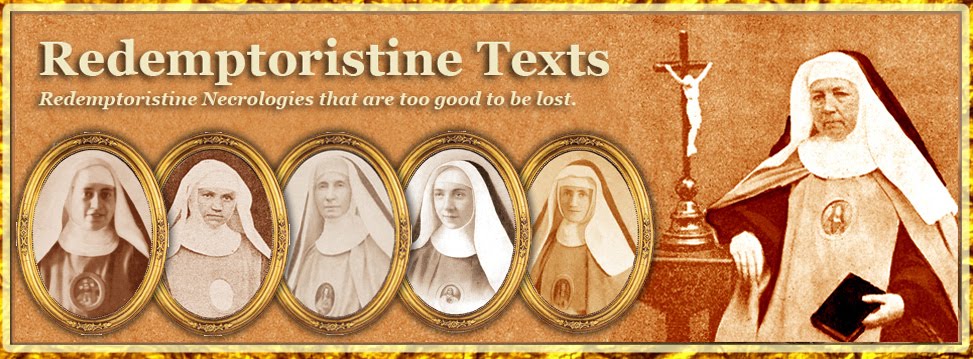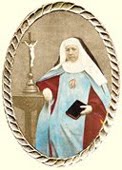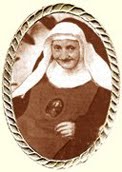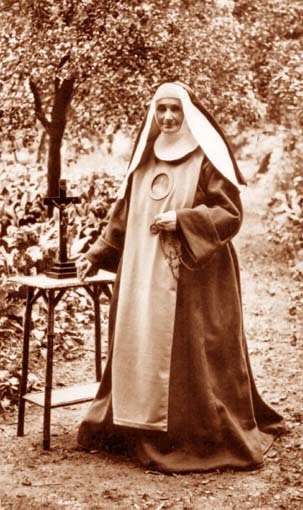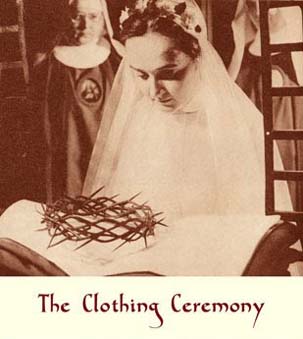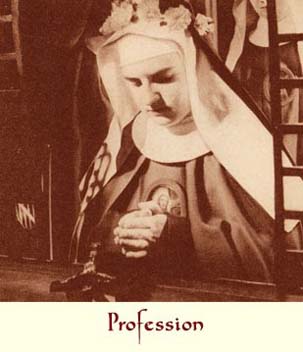* * MONASTERY OF MARIENTHAL * *
History of the Foundation of the Monastery
History of the Foundation of the Monastery
The Revolution of 1848 drove Redemptorists and Redemptoristines from Vienna, these last were then governed by Mother Marie-Célestine.
All hope of recovering the Monastery having disappeared, they thought it a good idea to evacuate the foreign Sisters first of all from Vienna, and send them back home to their own country. These Sisters were seven in number, and some of them originally came from the Rhineland and the others from Holland. They had to go back to their countries of birth dressed in the clothes of the poor, bringing with them only the most necessary things. On 16th April 1848, they arrived at Aix-la-Chapelle. The following day, a relative of one of them came to meet her and bring her to the Redemptoristines of Bruges, where she had asked for admission. The six other Sisters refused point blank to be separated: they waited at Aix-la-Chapelle for the arrival of the Very Rev. Father Heilig, then the Provincial of the Belgian Province. They desired to place themselves under the direction of this excellent religious.
As soon as he arrived, the Very Rev. Father Heilig showed the refugees a lively compassion and took a truly paternal care of them. He also worked hard to find them a suitable habitation. Thanks to his intervention, the good Sisters of Saint Elizabeth in Aix-la-Chapelle offered them asylum in their convent. The offer was joyfully accepted and the poor exiles were thus able to find retreat in the cloister and the good things that it offered: the affection and tender charity of the Sisters of Saint Elizabeth added another prize.
The Very Rev. Father Provincial equally recommended the little community to the good care of the Very Rev. Father Koeman, Rector of the Redemptorists of Wittem. He also rendered his best services to the Sisters. Although they were confessed every week by the confessor of the convent that was sheltering them, they went every month to be confessed by the Rev. Father Rector at Wittem, and receive his direction. From time to time, Father Koeman would go to Aix-la-Chapelle, or rather, he would send a Father from his community there to give them a spiritual conference. The Venerable Father Passerat visited them twice, and this was a great consolation to them. On 8th June, Mother Marie-Célestine arrived, accompanied by Sister Marie-Victoria. The joy at seeing each other again was great, and the good Sisters of Saint Elizabeth, sharing in the common joy, gave the newly arrived their own cells. In the month of September Sister Marie-Madeleine finally arrived with two other converse Sisters: all of them were welcomed with great goodness and housed for fifteen days.
* * * * *
However, they had to think of leaving the Sisters of Saint Elizabeth, whose devotion and charity had been above every eulogy. After many enquiries, the Rev. Father Rector of the Redemptorists of Wittem found at Galoppe (Dutch Limburg), at half a league from Wittem, a suitable house. The Reverend Mother Superior took it on rent, and it was leased from the beginning of October.
The farewells to the good Sisters of Saint Elizabeth were very touching: no one could forget, or will ever forget how much they consoled the sorrows of exile. The Redemptoristines left their charitable house and entered that of Galoppe on 14th October. Rev. Father Koeman celebrated Mass there the next day and left the Blessed Sacrament and also blessed the house.
The joy of possessing a convent was great; the consolation of finding themselves under the direction of the Fathers of the Congregation was no less. The Sisters remained in this house until 26th June 1851. A short time afterwards, the Very Rev. Father Heilig, the Provincial, arrived. He told the community that he had consulted the superior authorities and the Rev. Father Rector of Wittem: they had decided to purchase the sisters a new convent, this time a definitive one. “No difficulty,” he added, “could arise here about the purchase of a new house, because in this country we enjoy a great religious liberty.”
However, there would be one condition for entry into this Monastery, and each Sister had to accept the following conditions in writing: “The convent of Vienna, if ever it can be re-established, the Sister undertakes to never return there, but to remain in this new foundation. She would also use in favour of this new Monastery whatever remains of her fortune.” This done, the Very Rev. Father Heilig came with Rev. Father Smetana, the Vicar General of the Congregation beyond the Alps, to examine all the details relative to the construction of the convent. The land was bought in a little place called Partij, near Wittem. The Monastery was to be built in conformity with all the prescriptions of the Rule; and also in conformity with religious poverty.
It was on 5th October 1849 that the first stone of the new convent was laid. The honour went to the Very Rev. Father Heilig, the Provincial; the Rev. Father Rector laid the second. At the beginning, the building offered great difficulties as the soil constantly subsided. It became impossible to lay bricks and they had to be supported by beams. The architect saw no danger at all; but the construction required a great deal of time and could only advance slowly.
If the joy of the Sisters had been great when they entered their rented house at Galoppe, it was even more so when they entered Marienthal (Valley of Mary) as this was the name that the Very Rev. Father Provincial gave the convent, to the great contentment of the Sisters. So as to avoid attracting the general attention, they made their entry in the most complete silence on 26th June 1851. The chapel was consecrated to Our Lady of the Seven Sorrows. It was blessed as was the entire convent, in the name of Mons the Bishop of Roermond, by Rev. Father Koeman. The day after this ceremony, the Rev. Father Rector celebrated the first Mass, and from then on the Redeemer established Himself in the new house to be its source of graces.
* * * * *
The convent of Marienthal was now finally established: the Revolution, in rudely shaking the tree of the Institute of the Redemptoristines, had succeeded only in scattering its seeds afar, and Satan’s plans had been foiled once again by divine Providence.
A short while afterwards, religion recovered a greater liberty in Austria, under the reign of the young and pious Emperor Franz Joseph. On 23rd June 1852, the Sovereign signed a decree permitting the Redemptorists and Redemptoristines to re-enter the country, and the convent in Vienna was re-opened. At the same time a new foundation was also opened at Ried, in Lower Austria. The Sisters who were destined for this Monastery left the solitary cloister of Marienthal, which was so dear to them. They did not in the least doubt that great trials would crown their sacrifice. On 24th November they received the news of the death of Sister Marie-Xaviera and the great danger of death facing the Mother Superior. Then there was an epidemic of smallpox that ravaged the country and attacked the nuns. The Superior, Mother Marie-Madeleine, only recovered after long sufferings, but she did recover; may Our Lord be praised for it! Without her, this foundation would have suffered a great loss, and the return to Vienna could not have been made. Sister Marie-Madeleine had to leave the convent of Ried in 1853 in order to re-establish the convent of Vienna, and she was accompanied by two Sisters from Marienthal. Sister Marie-Victoria was then appointed to lead the Monastery of Ried.
However, the convent of Marienthal prospered more and more, and before the Kulturkampf burst onto the scene, there were plans to found a house in the Rhineland provinces. A large property was bought in the area of Koblenz-Vallenduri; and the Sisters had already been designated for this foundation, when the tempest of persecution broke out in fury against all the Catholic institutions of the German Empire. Later on, the house was sold at a loss, as there was no longer any hope of re-establishing it. In its place, the convent of Sambeek was founded near Boxmeer, in the north of Dutch Brabant. All the Sisters who were sent there, number 10 in all, were Dutch, except for the Superior. This house prospered rapidly and was visibly blessed from on high.
* * * * * * * * * *
In 1877, the convent of Marienthal was, in its turn, visited by a trial: a fire broke out and it destroyed it from top to bottom. This was on 25th January, the day when the Order pays very special honour to the holy Child Jesus. The beautiful Christmas crib was still exposed, and the novices had just offered up their last prayers to the divine Saviour there. Suddenly a cloud of smoke rose up from the Crib. A novice saw it and let out a cry, but it was too late! A piece of paper had caught fire from one of the candles surrounding the artificial rocks, and the flames soared up. A wooden wall which touched the crib and went up to the attic now caught fire in its turn. Soon the whole building was captured by the flames, in spite of incredible efforts by the Redemptorist Students and the people from nearby who came running at the sound of the alarm. This was right in the middle of the night. The fire pumps failed and everyone had to resign themselves to seeing their beautiful Monastery burn down. All that was left were the exterior walls. However, many objects were snatched from the flames, thanks to the devotion of the Students and at least there was no loss of life. The roof of the chapel was entirely consumed, but they were able to save the Blessed Sacrament and the most precious objects.
The same evening, the Rev. Father Rector of Wittem, later Mons. Wulfingh [1] left for the Franciscan Sisters at Nonnenwerth. They had rented an old mansion at Maastricht so they would have somewhere to go if they were persecuted. They immediately deferred to the Rev. Father Rector’s wishes and offered their hospitality to the Sisters of Marienthal. It was in this house, called “the Great Swiss House” that the community lived until the month of October of the same year. At this time, part of the new convent of Marienthal was built and finished.
“The good Fathers of Wittem offered us the greatest charity in these sorrowful circumstances. During the first week of our emigration, the Students and a converse Brother worked actively to put our house in order. From the spiritual point of view, we were very privileged. Three Fathers came in turn to the “Great Swiss House” and preached conferences for us every week. We also had the great happiness of possessing the Blessed Sacrament in this place of exile.
“When the tragedy became known, we received so many marks of sympathy and different kinds of gifts that it would take too long here to mention the names of our benefactors and the nature of their gifts. But the consolation and joy which came to us from our Holy Father, Pope Pius IX, is something we cannot fail to mention. When the Holy Pontiff heard the news about the fire, he asked for more information through the Nuncio in Holland, Mons. Capri. After he received the information he wanted from the Rev. Father Rector of Wittem, the Nuncio sent the sum of 3000 francs for the Redemptoristines of Marienthal. This generous gift, offered by the Vicar of Jesus Christ on earth, filled every heart with joy. We immediately sent the Holy Father, and also the Nuncio, the expression of our profound gratitude.
“Thanks to the speed with which the work of reconstruction was conducted, after three months of exile we were able to leave the “Great Swiss House” and return to our own Monastery. On 10th October the last Sisters arrived. Every time a carriage stopped in front of the convent, the three bells filled the air with their joyous song. Each time too, our hearts beat in unison. Gradually, as everything was repaired, we reverted to the customs of the former Monastery. The following year, we lost the last Choir Sisters who had suffered expulsion from Vienna, Sister Marie-Anne-Joseph and Mother Marie-Celestine. They died ten days apart.”
Some years later, the convent of Marienthal, which was now more flourishing than ever, was to introduce the Redemptoristines into America, and for the first time the Daughters of Saint Alphonsus brought the New World the help of their prayers and sacrifices. [2]
All hope of recovering the Monastery having disappeared, they thought it a good idea to evacuate the foreign Sisters first of all from Vienna, and send them back home to their own country. These Sisters were seven in number, and some of them originally came from the Rhineland and the others from Holland. They had to go back to their countries of birth dressed in the clothes of the poor, bringing with them only the most necessary things. On 16th April 1848, they arrived at Aix-la-Chapelle. The following day, a relative of one of them came to meet her and bring her to the Redemptoristines of Bruges, where she had asked for admission. The six other Sisters refused point blank to be separated: they waited at Aix-la-Chapelle for the arrival of the Very Rev. Father Heilig, then the Provincial of the Belgian Province. They desired to place themselves under the direction of this excellent religious.
As soon as he arrived, the Very Rev. Father Heilig showed the refugees a lively compassion and took a truly paternal care of them. He also worked hard to find them a suitable habitation. Thanks to his intervention, the good Sisters of Saint Elizabeth in Aix-la-Chapelle offered them asylum in their convent. The offer was joyfully accepted and the poor exiles were thus able to find retreat in the cloister and the good things that it offered: the affection and tender charity of the Sisters of Saint Elizabeth added another prize.
The Very Rev. Father Provincial equally recommended the little community to the good care of the Very Rev. Father Koeman, Rector of the Redemptorists of Wittem. He also rendered his best services to the Sisters. Although they were confessed every week by the confessor of the convent that was sheltering them, they went every month to be confessed by the Rev. Father Rector at Wittem, and receive his direction. From time to time, Father Koeman would go to Aix-la-Chapelle, or rather, he would send a Father from his community there to give them a spiritual conference. The Venerable Father Passerat visited them twice, and this was a great consolation to them. On 8th June, Mother Marie-Célestine arrived, accompanied by Sister Marie-Victoria. The joy at seeing each other again was great, and the good Sisters of Saint Elizabeth, sharing in the common joy, gave the newly arrived their own cells. In the month of September Sister Marie-Madeleine finally arrived with two other converse Sisters: all of them were welcomed with great goodness and housed for fifteen days.
* * * * *
However, they had to think of leaving the Sisters of Saint Elizabeth, whose devotion and charity had been above every eulogy. After many enquiries, the Rev. Father Rector of the Redemptorists of Wittem found at Galoppe (Dutch Limburg), at half a league from Wittem, a suitable house. The Reverend Mother Superior took it on rent, and it was leased from the beginning of October.
The farewells to the good Sisters of Saint Elizabeth were very touching: no one could forget, or will ever forget how much they consoled the sorrows of exile. The Redemptoristines left their charitable house and entered that of Galoppe on 14th October. Rev. Father Koeman celebrated Mass there the next day and left the Blessed Sacrament and also blessed the house.
The joy of possessing a convent was great; the consolation of finding themselves under the direction of the Fathers of the Congregation was no less. The Sisters remained in this house until 26th June 1851. A short time afterwards, the Very Rev. Father Heilig, the Provincial, arrived. He told the community that he had consulted the superior authorities and the Rev. Father Rector of Wittem: they had decided to purchase the sisters a new convent, this time a definitive one. “No difficulty,” he added, “could arise here about the purchase of a new house, because in this country we enjoy a great religious liberty.”
However, there would be one condition for entry into this Monastery, and each Sister had to accept the following conditions in writing: “The convent of Vienna, if ever it can be re-established, the Sister undertakes to never return there, but to remain in this new foundation. She would also use in favour of this new Monastery whatever remains of her fortune.” This done, the Very Rev. Father Heilig came with Rev. Father Smetana, the Vicar General of the Congregation beyond the Alps, to examine all the details relative to the construction of the convent. The land was bought in a little place called Partij, near Wittem. The Monastery was to be built in conformity with all the prescriptions of the Rule; and also in conformity with religious poverty.
It was on 5th October 1849 that the first stone of the new convent was laid. The honour went to the Very Rev. Father Heilig, the Provincial; the Rev. Father Rector laid the second. At the beginning, the building offered great difficulties as the soil constantly subsided. It became impossible to lay bricks and they had to be supported by beams. The architect saw no danger at all; but the construction required a great deal of time and could only advance slowly.
If the joy of the Sisters had been great when they entered their rented house at Galoppe, it was even more so when they entered Marienthal (Valley of Mary) as this was the name that the Very Rev. Father Provincial gave the convent, to the great contentment of the Sisters. So as to avoid attracting the general attention, they made their entry in the most complete silence on 26th June 1851. The chapel was consecrated to Our Lady of the Seven Sorrows. It was blessed as was the entire convent, in the name of Mons the Bishop of Roermond, by Rev. Father Koeman. The day after this ceremony, the Rev. Father Rector celebrated the first Mass, and from then on the Redeemer established Himself in the new house to be its source of graces.
* * * * *
The convent of Marienthal was now finally established: the Revolution, in rudely shaking the tree of the Institute of the Redemptoristines, had succeeded only in scattering its seeds afar, and Satan’s plans had been foiled once again by divine Providence.
A short while afterwards, religion recovered a greater liberty in Austria, under the reign of the young and pious Emperor Franz Joseph. On 23rd June 1852, the Sovereign signed a decree permitting the Redemptorists and Redemptoristines to re-enter the country, and the convent in Vienna was re-opened. At the same time a new foundation was also opened at Ried, in Lower Austria. The Sisters who were destined for this Monastery left the solitary cloister of Marienthal, which was so dear to them. They did not in the least doubt that great trials would crown their sacrifice. On 24th November they received the news of the death of Sister Marie-Xaviera and the great danger of death facing the Mother Superior. Then there was an epidemic of smallpox that ravaged the country and attacked the nuns. The Superior, Mother Marie-Madeleine, only recovered after long sufferings, but she did recover; may Our Lord be praised for it! Without her, this foundation would have suffered a great loss, and the return to Vienna could not have been made. Sister Marie-Madeleine had to leave the convent of Ried in 1853 in order to re-establish the convent of Vienna, and she was accompanied by two Sisters from Marienthal. Sister Marie-Victoria was then appointed to lead the Monastery of Ried.
However, the convent of Marienthal prospered more and more, and before the Kulturkampf burst onto the scene, there were plans to found a house in the Rhineland provinces. A large property was bought in the area of Koblenz-Vallenduri; and the Sisters had already been designated for this foundation, when the tempest of persecution broke out in fury against all the Catholic institutions of the German Empire. Later on, the house was sold at a loss, as there was no longer any hope of re-establishing it. In its place, the convent of Sambeek was founded near Boxmeer, in the north of Dutch Brabant. All the Sisters who were sent there, number 10 in all, were Dutch, except for the Superior. This house prospered rapidly and was visibly blessed from on high.
* * * * * * * * * *
In 1877, the convent of Marienthal was, in its turn, visited by a trial: a fire broke out and it destroyed it from top to bottom. This was on 25th January, the day when the Order pays very special honour to the holy Child Jesus. The beautiful Christmas crib was still exposed, and the novices had just offered up their last prayers to the divine Saviour there. Suddenly a cloud of smoke rose up from the Crib. A novice saw it and let out a cry, but it was too late! A piece of paper had caught fire from one of the candles surrounding the artificial rocks, and the flames soared up. A wooden wall which touched the crib and went up to the attic now caught fire in its turn. Soon the whole building was captured by the flames, in spite of incredible efforts by the Redemptorist Students and the people from nearby who came running at the sound of the alarm. This was right in the middle of the night. The fire pumps failed and everyone had to resign themselves to seeing their beautiful Monastery burn down. All that was left were the exterior walls. However, many objects were snatched from the flames, thanks to the devotion of the Students and at least there was no loss of life. The roof of the chapel was entirely consumed, but they were able to save the Blessed Sacrament and the most precious objects.
The same evening, the Rev. Father Rector of Wittem, later Mons. Wulfingh [1] left for the Franciscan Sisters at Nonnenwerth. They had rented an old mansion at Maastricht so they would have somewhere to go if they were persecuted. They immediately deferred to the Rev. Father Rector’s wishes and offered their hospitality to the Sisters of Marienthal. It was in this house, called “the Great Swiss House” that the community lived until the month of October of the same year. At this time, part of the new convent of Marienthal was built and finished.
“The good Fathers of Wittem offered us the greatest charity in these sorrowful circumstances. During the first week of our emigration, the Students and a converse Brother worked actively to put our house in order. From the spiritual point of view, we were very privileged. Three Fathers came in turn to the “Great Swiss House” and preached conferences for us every week. We also had the great happiness of possessing the Blessed Sacrament in this place of exile.
“When the tragedy became known, we received so many marks of sympathy and different kinds of gifts that it would take too long here to mention the names of our benefactors and the nature of their gifts. But the consolation and joy which came to us from our Holy Father, Pope Pius IX, is something we cannot fail to mention. When the Holy Pontiff heard the news about the fire, he asked for more information through the Nuncio in Holland, Mons. Capri. After he received the information he wanted from the Rev. Father Rector of Wittem, the Nuncio sent the sum of 3000 francs for the Redemptoristines of Marienthal. This generous gift, offered by the Vicar of Jesus Christ on earth, filled every heart with joy. We immediately sent the Holy Father, and also the Nuncio, the expression of our profound gratitude.
“Thanks to the speed with which the work of reconstruction was conducted, after three months of exile we were able to leave the “Great Swiss House” and return to our own Monastery. On 10th October the last Sisters arrived. Every time a carriage stopped in front of the convent, the three bells filled the air with their joyous song. Each time too, our hearts beat in unison. Gradually, as everything was repaired, we reverted to the customs of the former Monastery. The following year, we lost the last Choir Sisters who had suffered expulsion from Vienna, Sister Marie-Anne-Joseph and Mother Marie-Celestine. They died ten days apart.”
Some years later, the convent of Marienthal, which was now more flourishing than ever, was to introduce the Redemptoristines into America, and for the first time the Daughters of Saint Alphonsus brought the New World the help of their prayers and sacrifices. [2]
Footnotes
[1] Mons. Wulfingh died at sea in 1906 while returning to Surinam.
[2] The story of this foundation in Canada will be told later on.
This necrology is translated from Fleurs de l'Institut des Rédemptoristines by Mr John R. Bradbury. The copyright of this translation is the property of the Redemptoristine Nuns of Maitland, Australia. The integral version of the translated book will be posted here as the necrologies appear.
